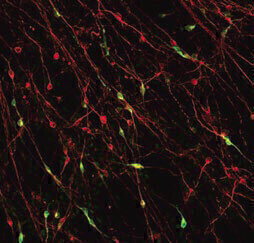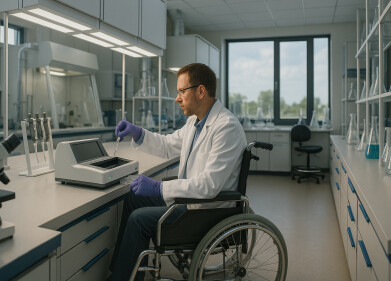-
 Dopamine neurons (in green) grown using stem cell technology
Dopamine neurons (in green) grown using stem cell technology
News
Researchers Grow Nerves for Parkinson’s Studies
Aug 10 2011
Oxford University researchers have succeeded in using stem cell technology to grow nerve cells in the laboratory from initial skin samples taken from Parkinson’s patients.
It’s the first large-scale effort of its kind in the UK. The advance will allow nerve cells that are just like those of the people with Parkinson’s to be studied intensively in the laboratory in ways that weren’t possible before.
The study aims to investigate what processes are making specific nerve cells, called dopamine neurons, die off as the disease progresses. “We can’t take bits of people’s brains when they are alive, of course,” said Dr Richard Wade-Martins of the Oxford Parkinson’s Disease Centre, who led the work. “So we never have been able to study dopamine neurons from a patient.
“We now have a platform to understand what happens in the cells in disease and identify new pathways that could lead to potential targets for new therapies.” Last month BBC News followed the steps in the process using cells of a skin biopsy taken from a patient with Parkinson’s; these were grown up in the lab and at the appropriate point, using an approach recently developed by Japanese scientists, the skin cells were ‘reprogrammed’ to revert back to a stem-cell-like state.
The great power of these induced pluripotent stem cells, or iPS cells, is that they are able to form just about any of the
specialised types of cell present in the body. This allowed the Oxford team to guide the iPS cells to develop, or ‘differentiate’, into nerve cells that were essentially identical to the patient’s own nerve cells in his brain including dopamine neurons, the ones involved in Parkinson’s disease.
Each of the stages in the process – skin cells to iPS cells to nerve cells – are visible under the microscope as they all look very different.
The clearly defined circular colony of stem cells gradually breaks up as nerve cells with their long thread-like projections appear, down which electrical signals can be transmitted resulting in a platform to improve our understanding of what happens in the cells in disease. The stem cell work is part of a bigger clinical study funded by
Parkinson’s UK involving around 2000 people with Parkinson’s disease in the Thames Valley region.
“We’re interested in biomarkers that can be predictors of disease, whether that’s aberrant proteins in the blood or MRI imaging signatures,” said Dr Wade-Martins. “It’s not a clinical trial of a drug, nor are we using stem cells as a therapy. What we will get is a fantastically well-characterised cohort of people that should help us pinpoint disease mechanisms.”
Digital Edition
Lab Asia Dec 2025
December 2025
Chromatography Articles- Cutting-edge sample preparation tools help laboratories to stay ahead of the curveMass Spectrometry & Spectroscopy Articles- Unlocking the complexity of metabolomics: Pushi...
View all digital editions
Events
Jan 21 2026 Tokyo, Japan
Jan 28 2026 Tokyo, Japan
Jan 29 2026 New Delhi, India
Feb 07 2026 Boston, MA, USA
Asia Pharma Expo/Asia Lab Expo
Feb 12 2026 Dhaka, Bangladesh


















